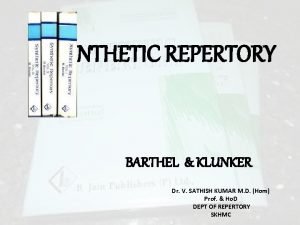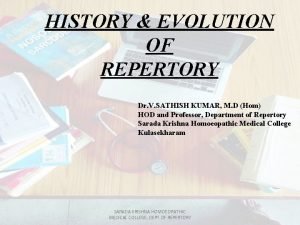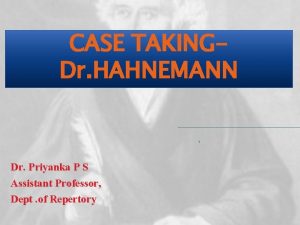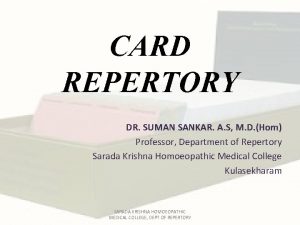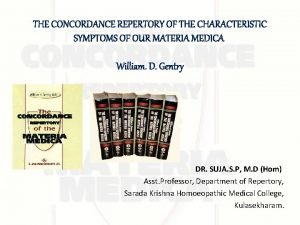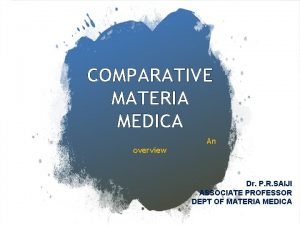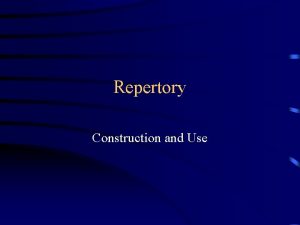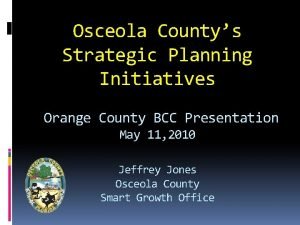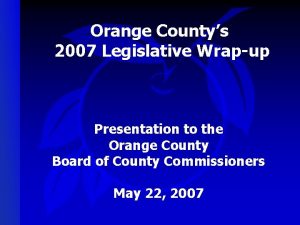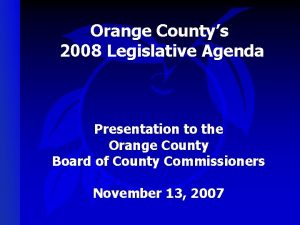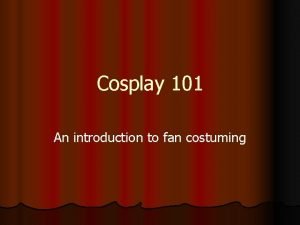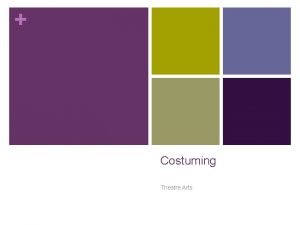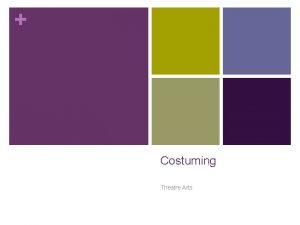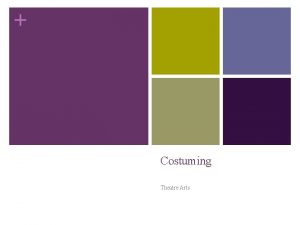Costuming South Coast Repertory Orange Countys Tony Awardwinning


















- Slides: 18

Costuming @ South Coast Repertory � � Orange County’s Tony Award-winning Theatre 655 Town Center Drive, Costa Mesa, Ca 92626 Department SOCCCD Collaborative 2008 -2009 CTE Grant Funded Externship Presentation by JD Nowland Part-time Faculty, Fashion Saddleback College, Fall 2008

For over 45 years South Coast Repertory has presented exciting theatre for Southern California audiences. South Coast Repertory was Orange County’s first resident theatre facility and the flagship of Orange County theatre. It was founded in 1964 by David Emmes and Martin Benson who successfully transformed South Coast Repertory from a storefront on Balboa Peninsula to it’s current multi-million dollar two-theatre complex; the 336 -seat Julianne Argyros Stage and the 550 seat Segerstrom Stage. South Coast Repertory is committed to staging challenging, quality plays with visiting artists, actors and gifted staff. A current offering was “The Heiress” directed by Martin Benson

The play “ The Heiress ”by Ruth and Augustus Goetz is an adaptation of the Henry James novel, Washington Square. Set a decade before the Civil War in 1850’s Manhattan it is the sad tale of a search for love and acceptance. “ The Heiress ” has a small cast of nine characters who witness and experience the cruelties and complexities of human relationships. Much of the status, emotions and personalities of the characters is conveyed through costuming.

Costumes visually define a character by establishing their emotions, wealth and reflecting changes. “The Heiress” as a historical play with emotionally complex themes was an ideal opportunity to observe the costume designer and costume staff at South Coast Repertory meet these costuming challenges

Amy Hutto ( far right ) and some of her talented staff South Coast Repertory’s costume manager, Amy Hutto was very positive about the possibility of Saddleback College enriching its fashion classes to incorporate costuming techniques. She agreed “ The Heiress” with approximately 30 costumes was an ideal opportunity to observe the creative and practical process of costuming. My goal for the SOCCCD Collaborative 20082009 CTE Grant Funded Externship was to learn enough about theatrical costuming to fully understand the many differences between fashion and costuming.

The Costume Designer for “The Heiress” was Maggie Morgan. She is a full-time associate professor at UC Davis and a busy free lance costume designer. Historical plays are among Maggie’s favorite costuming challenges. To begin the creative process Maggie compiles a very thick, complete ‘inspiration notebook’ full of images from books, period publications, art, anything related to the play’s historical setting. The ‘inspiration notebook’ is used to help visually explain her costuming choices.

Before a stitch is sewn the costume designer attends design meetings with the director, set designer, and lighting designer. Together they all communicate their vision of the overall production. So costume designers are part of a collaboration and fashion designers are not. A costumes’ main purpose is to convey information to the audience, not to necessarily make the actor look good. The fashion designer is free to make unlimited choices and the costume designers’ choices are limited and dictated by many variables.

An essential skill for the costume designer is the ability to accurately illustrate garment details. These renderings convey to the directors, designers and costume technicians the fabrics, proportions, emotional content, and construction detail necessary to understand the finished costume. Most fashion illustrations are much less detailed.

Once Maggie’s renderings were complete the costume designer faced the daunting task of making the costume designs a reality. Operating within budget restraints and with her assistants’ help the designer had three choices; rent the costume, pull the costume from the South Coast Repertory’s inventory of previously made costumes, or make the costume. Usually a designer uses a combination of the three choices because; actors come in many shapes and sizes, the costumes must compliment each other, and each costume must convey important information about the character ( rich, poor, happy, sad, old, young, repressed, exuberant, etc ). The decision on each costume is an exhaustive, ongoing event that the costume designer can change and modify many times over in the 3 to 4 weeks the costume team had to create the costumes.

Costumes must communicate volumes more information to a viewer than any fashion garment. Fabric selection for costumes contribute to the visual information and are well thought out with specific reasons for each decision. Velvety fabrics can be sensuous, stiff fabrics are rigid, textured fabrics can look wealthy, roughly woven fabrics can imply poverty. Period plays like “ The Heiress ” must also consider fabrics original to the period versus modern synthetic fabrics. Usually it is a combination of both because modern synthetic fabrics are easier to maintain.

Another very important tool for the costume designer is color. The most powerful uses of color is to display emotions. In these examples from “ The Heiress ” Maggie placed the actress in garish red when she is giddy; monotone white when somber and quiet. Swatches of fabric for texture and color combinations are attached to costume renderings to help the costume designer visualize the show and present ideas to the director.

Once Maggie had completed her renderings, collaborated with the director and other designers, confirmed the measurements of the actors, rented numerous costumes, pulled others from South Coast Repertory inventory, and purchased fabrics, finally the costume staff begins the construction of the remaining costumes. South Coast Repertory costume shop employs three full-time stitchers, draper/cutters and assistant to the designer in addition to Amy Hutto the shop manager. Their backgrounds vary from practical experience, to advanced degrees in apparel and costuming. For the costuming demands of “ The Heiress ” approximately nine overstaff employees were also hired. Every employee was knowledgeable of the main differences between costuming and fashion garments.

Main differences between costumes and fashion garments • Audience is not able to see small details. The broad general effect is most important. Silhouettes and details can be exaggerated more than in fashion garments. • Costumes are made for very quick changes. Actors frequently have minutes to quickchange in or out of a costume. Often costume closures differ from choices of fashion closures. • Costumes may be subjected to very rough treatment. Characters may fight, fall, crawl, jump out of windows, etc. Stronger construction of seams and hems than fashion garments. • Costumes need to be easily altered to fit other actors, especially period costumes that are costly to create and more elaborate. Large seam allowances, deep hems and expandable features make alterations easier. In fashion garments these features could create uncomfortable bulk.

Regan was the craft person for “ The Heiress ” In addition to creating garments, costuming also has specialties. “ The Heiress ” required period frock coats and a theatrical tailor that understood men’s suit construction was hired. There is usually a wig master that will style and maintain the wigs. There is also wardrobe supervising and costume maintenance. They oversee the laundering and dry cleaning of the costumes. They also organize the costumes before each show and perform any repairs. Wardrobe helps the actors get dressed and make costume changes. Maintenance oversees striking the show at the end of its run. The craft person is responsible for millinery ( hats), accessories, dying any fabrics or garments, painting shoes, making masks, gloves, jewelry, etc. The craft person must be well versed in many mediums.

rendering construction From inspiration to the finished costume South Coast Repertory provided an in depth view of the costume process. The staff and designers were available and receptive to all questions. This information is an invaluable asset in the goal of creating curriculum to prepare students for the costuming industry. fittings finished costume

Possible additions to current fashion curriculum FASH 111 FASHION SEWING-INTERMEDIATE • closures for quick changes • grow tucks • continuous lap placket • Hollywood waist FASH 31 TEXTILES • modern fabric substitutes ( i. e. . , Miracle net replaces crinoline) • non-traditional materials • emphasize popular period “looks” in fabrics • fabrics and dyes developed FASH 230 ALTERATIONS AND FITTING • fine tuning fit from measurements FASH 154 FASHION ILLUSTRATION • color renderings w/fabric swatches • emphasize details ( i. e. , seaming for patternmaker, identify fabric ) • illustrate evolution of character ( i. e. , rich to poor, happy to sad, young to old ) • incorporate use of “ inspiration” for illustration ( i. e. , postcards, images, colors ) FASH 124 WEARABLE ART • cartridge pleating FASH 144 FASHION TRENDS AND CULTURAL COSTUMES • historically correct construction techniques ( i. e. , when were darts, zippers introduced ) • placement of shoulder seams • what fabrics, dyes accessible • emphasize silhouettes thru history FASH 240 DYE PROCESSES ON FABRICS • how to ‘ knock down ’ colors • fabric modifications • ( i. e. , faux finishes ) • how to distress/age fabrics • painting shoes FASH 130 FLAT PATTERN DESIGN • larger seam allowances • incorporate need for possible future alterations • historically correct garment construction techniques • slight exaggerations to design to compensate for distance to stage • marriage of old techniques/period feel with modern ascetic

JOBS IN COSTUMING AT SOUTH COAST REPERTORY Costume designer: design, coordinate, and supervise the execution of costumes Costume Shop Manager: responsible for supervision of personnel, maintenance of equipment, purchase of supplies, scheduling work Assistant Costume Designer: research, swatch fabrics, organize, take notes, any job required by the designers Costume Technician: skilled in pattern making and construction. Capable of creating costume from sketches Cutter/Draper: responsible for making patterns, cutting all parts of the garment, and preparing the garment for stitching. First Hand: assistant to the patternmaker Stitcher: entry level position, stitches the costumes together. Craftsperson: skilled in a variety of costume and prop-related crafts. Responsible for millinery, dyeing, fabric painting, etc. Wardrobe Supervisor: responsible for laundry, dry cleaning, repairs, pre-show setup and quick changes Overstaff: temporary employees hired by the costume shop manager

MANY THANKS… • Amy Hutto, Maggie Morgan and the staff at South Coast Repertory • • Penelope Skaff and CTE Advisory Committee at Saddleback College • Lindsay Fox and Advanced Technology & Applied Science Division • Photographer Cindy Yamanaka and The Orange County Register • Applications Specialist II Kathleen Constance and Innovation and Technology Center • Tom, Christine & Sarah •
 Elim - cape south coast
Elim - cape south coast Fill in the gaps using the right preposition of time
Fill in the gaps using the right preposition of time Old south vs new south streetcar named desire
Old south vs new south streetcar named desire Synthesis repertory pdf
Synthesis repertory pdf Bell's diarrhoea repertory
Bell's diarrhoea repertory Pathological generals in repertory
Pathological generals in repertory Sycosexual
Sycosexual Radar full form in repertory
Radar full form in repertory Conjoint malady in repertory
Conjoint malady in repertory Evolution of repertory
Evolution of repertory Leuco phlegmatic
Leuco phlegmatic Bbcr repertory ppt
Bbcr repertory ppt Priyanka ps
Priyanka ps Card repertories
Card repertories Gentry repertory ppt
Gentry repertory ppt Bell's diarrhoea repertory
Bell's diarrhoea repertory Potential differential field in repertory
Potential differential field in repertory Alphabetical repertory examples
Alphabetical repertory examples Boger boenninghausen characteristic repertory
Boger boenninghausen characteristic repertory



